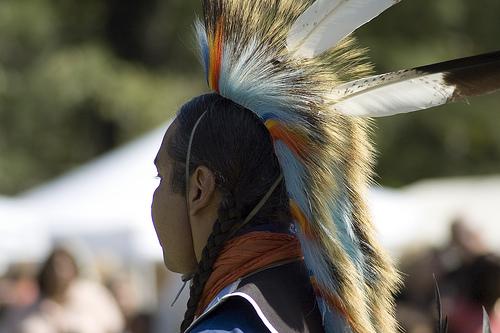Easy text: Native Americans Today


The most famous native tribes that the European settlers met were the Sioux, the Navajo, the Apaches and the Cherokees. It is difficult to give exact numbers, but it is estimated that the native population was about 1.5 million. They represented different tribes, each with its own language and culture. Hiawatha probably was a chief from a tribe called the Iroquois and Pocahontas was the daughter of a Powhatan chief.
When Christopher Columbus in 1492 set sail from a Spanish harbor, he was heading for India. Two months later he spotted land and thought he was in India, when actually, he had landed on an American island. Consequently, he thought that the first people he met were Indians. Due to this mistake, the Native Americans have been called Indians for 500 years. Columbus had to report back to the Spanish queen. This is what he wrote about the natives: “They ought to make good and skilled servants, for they repeat very quickly whatever we say to them. I think they can very easily be made Christians, for they seem to have no religion.”
To start with the relations between the American natives and the first settlers of North America were friendly. This gradually changed. Throughout the 1800s new settlers arrived every day and they needed more space. The tribes had never thought of the land as belonging to them. To them, it was the Great Spirit that had created the land for them to use. On the prairie they hunted the buffalo with their bows and arrows and every part of the animal was used. The white man, however, brought with them modern weapons and wanted to have their own parcels of farmland. Not only did the white man bring with them modern ways of living, they also introduced the natives to dangerous diseases that they had no immunity against. One of the diseases that claimed many victims was smallpox.
After the Indian Removal Act was passed in 1830, five tribes (100,000 people in all) were forced to move from their hunting grounds and homelands. One of these removals is known as the “Trail of Tears”. When gold was discovered in an area in Georgia inhabited by Cherokees, the tribe was forced to move in 1839. It was freezing winter, many of the Native Americans had to walk barefoot and 4,000 (among them many children) did not survive the long trail to their destination in Oklahoma, where the authorities had set aside an area that they called Indian Territory. This was the first reservation that was established. There were more to come….
In 1860 The Homestead Act was passed giving settlers 160 acres of farmland for free. In this way the authorities wanted to encourage Europeans to establish farms on the former tribal hunting grounds, the prairie. Many of the tribes had been forced to move to Oklahoma in the years before this. This was a definite blow for the natives and their favorite animal, the buffalo.
Starting with Oklahoma, reservations all over the North American continent were created to control the Native Americans. The land that they were given by the authorities was infertile and they had to give up their original way of living. This led them into poverty and a sad side effect was that many of the once proud Indians became alcoholics and drug addicts. Many of the children were taken away from their parents and taught how to be “good” Americans, which basically meant to behave like the whites. In this way the Native Americans lost important parts of their culture and the number of North American Indians decreased from 1.5 million in the 1500s to 350,000 (1920).
A new act in 1924 finally gave the Native Americans full American citizenship and therefore more rights. Money was given in compensation for the land that had been given to the white man. Some of the investments the Native Americans made were in the gambling business. Many reservations established casinos which became an important source of income.
Today there are about 2.8 million Native Americans, or American Indians, as some prefer to call themselves. They are represented by 562 different tribes living in cities or on the 300 reservations in the United States. Statistics show that the Native Americans are among the poorest citizens in the USA. However, several Native Americans take pride in their culture and history. Maybe we should all learn a lesson from the Native Americans and how they respected and worshipped Nature.